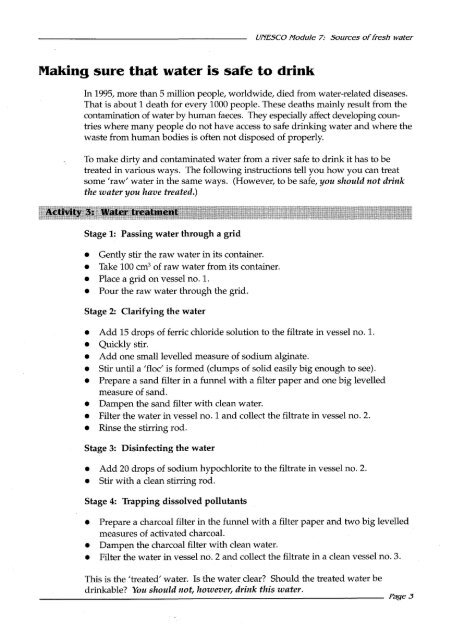UNESCO resource kit - science and technology educa...
UNESCO resource kit - science and technology educa...
UNESCO resource kit - science and technology educa...
Create successful ePaper yourself
Turn your PDF publications into a flip-book with our unique Google optimized e-Paper software.
Making sure that water is safe to drink<br />
<strong>UNESCO</strong> Module 7: Sources of fresh water<br />
In 1995,more than 5 million people, worldwide, died from water-related diseases.<br />
That is about 1 death for every 1000people. These deaths mainly result from the<br />
contamination of water by human faeces. They especially affectdeveloping countries<br />
where many people do not have access to safe drinking water <strong>and</strong> where the<br />
waste from human bodies is often not disposed of properly.<br />
To make dirty <strong>and</strong> contaminated water from a river safe to drink it has to be<br />
treated in various ways. The following instructions tell you how you can treat<br />
some 'raw' water in the same ways. (However, to be safe, you should not drink<br />
the water you have treated.)<br />
Stage 1: Passing water through a grid<br />
• Gently stir the raw water in its container.<br />
• Take 100 em" of raw water from its container.<br />
• Place a grid on vessel no. 1.<br />
• Pour the raw water through the grid.<br />
Stage 2: Clarifying the water<br />
• Add 15 drops of ferric chloride solution to the filtrate in vessel no. 1.<br />
• Quickly stir.<br />
• Add one small levelled measure of sodium alginate.<br />
• Stir until a 'floc' is formed (clumps of solid easily big enough to see).<br />
• Prepare a s<strong>and</strong> filterin a funnel with a filter paper <strong>and</strong> one big levelled<br />
measure of s<strong>and</strong>.<br />
• Dampen the s<strong>and</strong> filter with clean water.<br />
• Filter the water in vessel no. 1 <strong>and</strong> collect the filtrate in vessel no. 2.<br />
• Rinse the stirring rod.<br />
Stage 3: Disinfecting the water<br />
• Add 20 drops of sodium hypochlorite to the filtrate in vessel no. 2.<br />
• Stir with a clean stirring rod.<br />
Stage 4: Trapping dissolved pollutants<br />
• Prepare a charcoal filter in the funnel with a filter paper <strong>and</strong> two big levelled<br />
measures of activated charcoal.<br />
• Dampen the charcoal filter with clean water.<br />
• Filter the water in vessel no. 2 <strong>and</strong> collect the filtrate in a clean vessel no. 3.<br />
This is the 'treated' water. Is the water clear? Should the treated water be<br />
drinkable? You should not, however, drink this water.<br />
______________________________________________ ~ Page 3

















